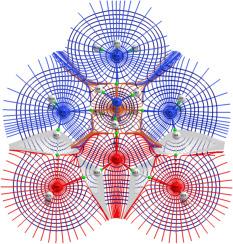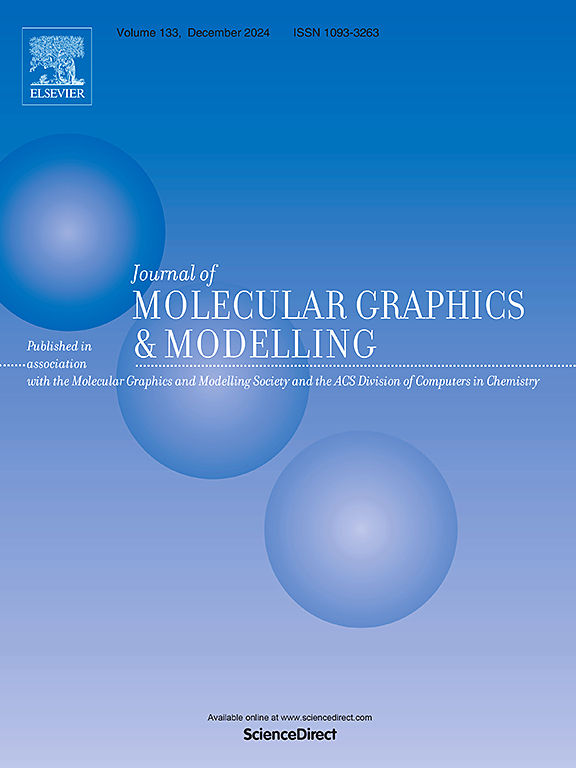水-氨混合物中溶解的亚铁离子簇:结构与非共价相互作用
IF 2.7
4区 生物学
Q2 BIOCHEMICAL RESEARCH METHODS
引用次数: 0
摘要
金属离子的行为通常在纯溶剂中进行研究,但在我们的日常生活中,这些金属会与混合溶剂发生作用。在本研究中,我们研究了水氨混合溶剂中溶解的亚铁离子在 0 K 和 25 K 至 400 K 不同温度下的结构、相对稳定性和温度依赖性。为了深入理解水-氨混合溶剂中溶解的亚铁离子的结合模式,我们基于使用 AIMAll 进行的 QTAIM 分析提出了非共价相互作用。我们的研究结果证明,当亚铁离子被氨水而不是水溶解时,其稳定性更高。此外,氢键也会因为氨分子的存在而减弱。不同几何形状的温度依赖性表明,从 s=6(s 是亚铁离子周围水分子和氨分子的总和)开始,当水分子数几乎等于氨分子数时,配位数为 5 的结构占主导地位。然而,当亚铁离子周围的水分子数最多(富水溶液)或氨分子数最多(富氨溶液)时(s≥6),配位数为 6。QTAIM 分析表明,存在两个配位键和四个氢键。此外,研究还发现,Fe2+⋯N 配位键比 Fe2+⋯O 强,这证实了亚铁离子更喜欢被氨溶解,而不是被水溶解。本文章由计算机程序翻译,如有差异,请以英文原文为准。

Clusters of solvated ferrous ion in water–ammonia mixture: Structures and noncovalent interactions
The behavior of metal ions is commonly studied in pure solvent although, in our daily life, these metals are involved in mixtures of solvents. In the present study, we investigated structures, relative stabilities and temperature dependance of solvated ferrous ion in water–ammonia mixture solvent at 0 K and at various temperatures ranging from 25 K to 400 K. All the calculations are performed at the MN15 level of theory associated with the aug-cc-pVDZ basis set. For deep understanding of binding patterns in solvated ferrous ion in water–ammonia mixture solvent, noncovalent interactions are presented based on the QTAIM analysis using AIMAll. Our results prove that the ferrous ion is more stable when it is solvated by ammonia instead of water. In addition, hydrogen bonds are weakened by the presence of ammonia molecules. The temperature dependence of the different obtained geometries indicates that from ( is the sum of water and ammonia molecules around the ferrous ion), when the number of water molecules is almost equal to that of ammonia, the structures with coordination number 5 are dominant. However, the coordination number is six when there are a maximum water molecules (rich water solution) or maximum ammonia molecules (rich ammonia solution) around the ferrous ion (for ). The QTAIM analysis shows that there are two coordination bondings and four hydrogen bondings. Furthermore, it is found that the FeN coordination bondings are stronger than the FeO confirming that the ferrous ion prefers to be solvated by ammonia instead of water.
求助全文
通过发布文献求助,成功后即可免费获取论文全文。
去求助
来源期刊

Journal of molecular graphics & modelling
生物-计算机:跨学科应用
CiteScore
5.50
自引率
6.90%
发文量
216
审稿时长
35 days
期刊介绍:
The Journal of Molecular Graphics and Modelling is devoted to the publication of papers on the uses of computers in theoretical investigations of molecular structure, function, interaction, and design. The scope of the journal includes all aspects of molecular modeling and computational chemistry, including, for instance, the study of molecular shape and properties, molecular simulations, protein and polymer engineering, drug design, materials design, structure-activity and structure-property relationships, database mining, and compound library design.
As a primary research journal, JMGM seeks to bring new knowledge to the attention of our readers. As such, submissions to the journal need to not only report results, but must draw conclusions and explore implications of the work presented. Authors are strongly encouraged to bear this in mind when preparing manuscripts. Routine applications of standard modelling approaches, providing only very limited new scientific insight, will not meet our criteria for publication. Reproducibility of reported calculations is an important issue. Wherever possible, we urge authors to enhance their papers with Supplementary Data, for example, in QSAR studies machine-readable versions of molecular datasets or in the development of new force-field parameters versions of the topology and force field parameter files. Routine applications of existing methods that do not lead to genuinely new insight will not be considered.
 求助内容:
求助内容: 应助结果提醒方式:
应助结果提醒方式:


